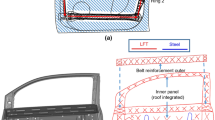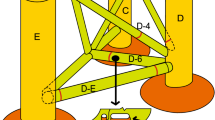Abstract
Refuelling is an important activity in the daily routines at airports. Airport oil pits are covered, requiring a special pit-opener to open its lid. After using the pit-opener, there is no designated place to store the pit-opener. Due to the weight of the pit-opener, workers have difficulty in opening, carrying and using the existing pit-opener, which poses risks of musculoskeletal injuries. Often, workers would throw the tool to the ground, causing impact or possible damage. Hence, there is a need for a new pit-opener design to solve this problem, which is lightweight and high-strength. An invention of a new Pit-Opener (DAG) is presented, comprising of a flexible hook at one side and a fixed hook at the adjacent side. In addition, the Pit-Opener (DAG) consists of a handle, stowage bracket and body support. The objective of this paper is to determine the optimal configurations by mass reduction of the DAG prototype. The functionality of DAG has significantly improved the airport worker’s job with regards to ease of use, however, the prototype may still be heavy for long repetitive use. The methodology used in this study consists of using a reverse engineering process to create a CAD model based upon the DAG prototype, conducting stress analysis study and interactive design through a user-centered and systematic design approach. Consequently, the optimization process of the pit-opener design was performed via stress analysis using a Finite-Element Analysis (FEA) tool through iterations with different configurations to obtain the final optimised design. The results permitted an overall further weight reduction of 2 kg of the existing prototype, without sacrificing performance. An evaluation of the model using the Parsimony, Exactness, Precision, Specialization (PEPS) method was used for validation. In conclusion, DAG provides cost-effective, vital, safe and secured storage of efficient pit opening for oil tanker application, and through structural analysis, suitable configurations of the pit-opener were determined.

























Similar content being viewed by others
References
Ganesan, V., Saudi, A.S., Balakrishnan, A., Shafii, N.Z., Kamarudin, M.K., Khairuddin, M.Z., Amin, N.A., Abu, I.F., Ridzuan, I.S.: An ergonomic assessment of musculoskeletal disorders among airport bag handlers: a case study in Malaysia. Int. J. Res. Pharm. Sci. 9(2), 83–87 (2018)
Asadi, H., Mott, J. H., Yu, D.: Risk factors for musculoskeletal injuries among airport customer service employees. In: Proceedings of the Human Factors and Ergonomics Society Annual Meeting, vol. 63, no. 1, pp. 1964–1968 (2019)
Rosskam, E., Drewczynski, A., Bertolini, R.: The Insecurities of Service: Airport Check-In Workers. Routledge, New York (2005)
Møller, S.P., Brauer, C., Mikkelsen, S., Alkjær, T., Koblauch, H., Pedersen, E.B., Simonsen, E.B., Thygesen, L.C.: Risk of subacromial shoulder disorder in airport baggage handlers: combining duration and intensity of musculoskeletal shoulder loads. Ergonomics 61(4), 576–587 (2018)
Rothrock, G.R.: U.S. Patent No. 5,673,810. U.S. Patent and Trademark Office, Washington, DC (1997)
Watkins, O., Sell, E. A.: U.S. Patent No. 8,511,351. U.S. Patent and Trademark Office, Washington, DC (2013)
Nasidin, N., Deros, B.M., Daruis, D.D.I., Hasan, N., Khalid, M.S.: Evaluation of work posture and repetitive work of quality inspectors by RULA and OCRA. J. Sci. Technol. Innov. Policy 6(1), 34–57 (2020)
Jain, R., Rana, K.B., Meena, M.L., Sidh, S.: Ergonomic assessment and hand tool redesign for the small scale furniture industry. Mater. Today: Proc. 44, 4952–4955 (2021)
Ayoub, M.M., Mital, A.: Manual Materials Handling: Design and Injury Control Through Ergonomics. CRC Press, New York (2020)
Yildiz, A.R., Kaya, N., Ozturk, F., Alankus, O.: Optimal design of vehicle components using topology design and optimisation. Int. J. Veh. Des. 34(4), 387–398 (2004)
Leite, M., Silva, A., Henriques, E., Madeira, J.F.A.: Materials selection for a set of multiple parts considering manufacturing costs and weight reduction with structural isoperformance using direct multisearch optimization. Struct. Multidiscip. Optim. 52(4), 635–644 (2015)
Srivastava, J.P., Reddy, G.G., Teja, K.S.: Numerical investigation on vibration characteristics and structural behaviour of different go-kart chassis configuration. Mater. Today: Proc. 39, 176–182 (2021)
Fischer, X., Fadel, G., Ledoux, Y.: Interactive product design. In: Research in Interactive Design, vol. 3, pp. 45–84. Springer, Paris (2011)
Ahmed, S., Zhang, J., Demirel, O.: Assessment of types of prototyping in human-centered product design. In: International Conference on Digital Human Modeling and Applications in Health, Safety, Ergonomics and Risk Management, pp. 3–18. Springer, Cham (2018)
Boy, G.A.: Human-centered design of complex systems: An experience-based approach. Des. Sci. 3, E8 (2017)
Wang, C., Qiu, Z., Wang, X., Wu, D.: Interval finite element analysis and reliability-based optimization of coupled structural-acoustic system with uncertain parameters. Finite Elem. Anal. Des. 91, 108–114 (2014)
Suratkar, A., Shukla, V., Zakiuddin, D.K.: Design optimization of overhead EOT crane box girder using finite element analysis. Int. J. Eng. Res. Tech. 2(7), 720–724 (2013)
Vanam, B.C.L., Rajyalakshmi, M., Inala, R.: Static analysis of an isotropic rectangular plate using finite element analysis (FEA). J. Mech. Eng. Res. 4(4), 148–162 (2012)
Bechly, M.E., Clausen, P.D.: Structural design of a composite wind turbine blade using finite element analysis. Comput. Struct. 63(3), 639–646 (1997)
Banginwar, A.P., Bhusale, N.D., Totawar, K.V.: Design and analysis of shock absorber using FEA tool. Int. J. Eng. Res. Dev. 10(2), 22–28 (2014)
Nicholls, T., Crisan, R.: Study of the stress-strain state in corner joints and box-type furniture using Finite Element Analysis (FEA). Holz als Roh-und Werkstoff. 60(1), 66–71 (2002)
Poniewierski, J.: Guidelines and considerations for open pit designers. In: Deswik Delivering Mining Efficiency, vol. 16 (2018)
Talabi, S.I.A., Owolabi, O.B.B., Adebisi, J.A.A., Yahaya, T.A.: Effect of welding variables on mechanical properties of low carbon steel welded joint. Adv. Prod. Eng. Manag. 9(4), 181–186 (2014)
Azizi, A., Yazdi, P.G., Hashemipour, M.: Interactive design of storage unit utilizing virtual reality and ergonomic framework for production optimization in manufacturing industry. Int. J. Interact. Des. Manuf. (IJIDeM) 13(1), 373–381 (2019)
Papetti, A., Ciccarelli, M., Brunzini, A., Germani, M.: Design of ergonomic manufacturing equipment by a human-centered methodology. Int. J. Interact. Des. Manuf. (IJIDeM) 15, 1–5 (2020)
Ashby, M.F., Shercliff, H., Cebon, D.: Materials: Engineering, Science, Processing and Design. Butterworth-Heinemann, Oxford (2018)
Jahan, A., Edwards, K.L., Bahraminasab, M.: Multi-criteria Decision Analysis for Supporting the Selection of Engineering Materials in Product Design. Butterworth-Heinemann, Oxford (2016)
Mgbemena, C.E., Oyekan, J., Hutabarat, W., Xu, Y., Tiwari, A.: Design and implementation of ergonomic risk assessment feedback system for improved work posture assessment. Theor. Issues Ergon. Sci. 19(4), 431–455 (2018)
Boy, G.A.: Tangible Interactive Systems. Springer, Cham (2016)
Azman, A.H., Vignat, F., Villeneuve, F., Nguyen, D.S.: Creation of lattice structures with skeleton model for additive manufacturing. Int. J. Interact. Des. Manuf. (IJIDeM) (2020). https://doi.org/10.1007/s12008-021-00767-z
Seharing, A., Azman, A.H., Abdullah, S.: Finite element analysis of gradient lattice structure patterns for bone implant design. Int. J. Struct. Integr. 11(4), 535–545 (2020)
Vernat, Y., Nadeau, J.P., Sébastian, P.: Formalization and qualification of models adapted to preliminary design. Int. J. Interact. Des. Manuf. (IJIDeM) 4(1), 11–24 (2010)
Vernat, Y.: Formalizing and qualifying models for constraint-based embodiment design. Doctoral dissertation, Arts et Métiers ParisTech (2004)
Funding
This study [FF-2018-237] was made possible with the funding from Research University Grant GUP-2019-080.
Author information
Authors and Affiliations
Corresponding author
Additional information
Publisher's Note
Springer Nature remains neutral with regard to jurisdictional claims in published maps and institutional affiliations.
Rights and permissions
About this article
Cite this article
Azman, A.H., Hishamuddin, H., Daud, F. et al. Interactive design and structural analysis of pit-opener DAG for airport oil tanks based on user-centered design and finite element analysis. Int J Interact Des Manuf 15, 541–553 (2021). https://doi.org/10.1007/s12008-021-00780-2
Received:
Accepted:
Published:
Issue Date:
DOI: https://doi.org/10.1007/s12008-021-00780-2




